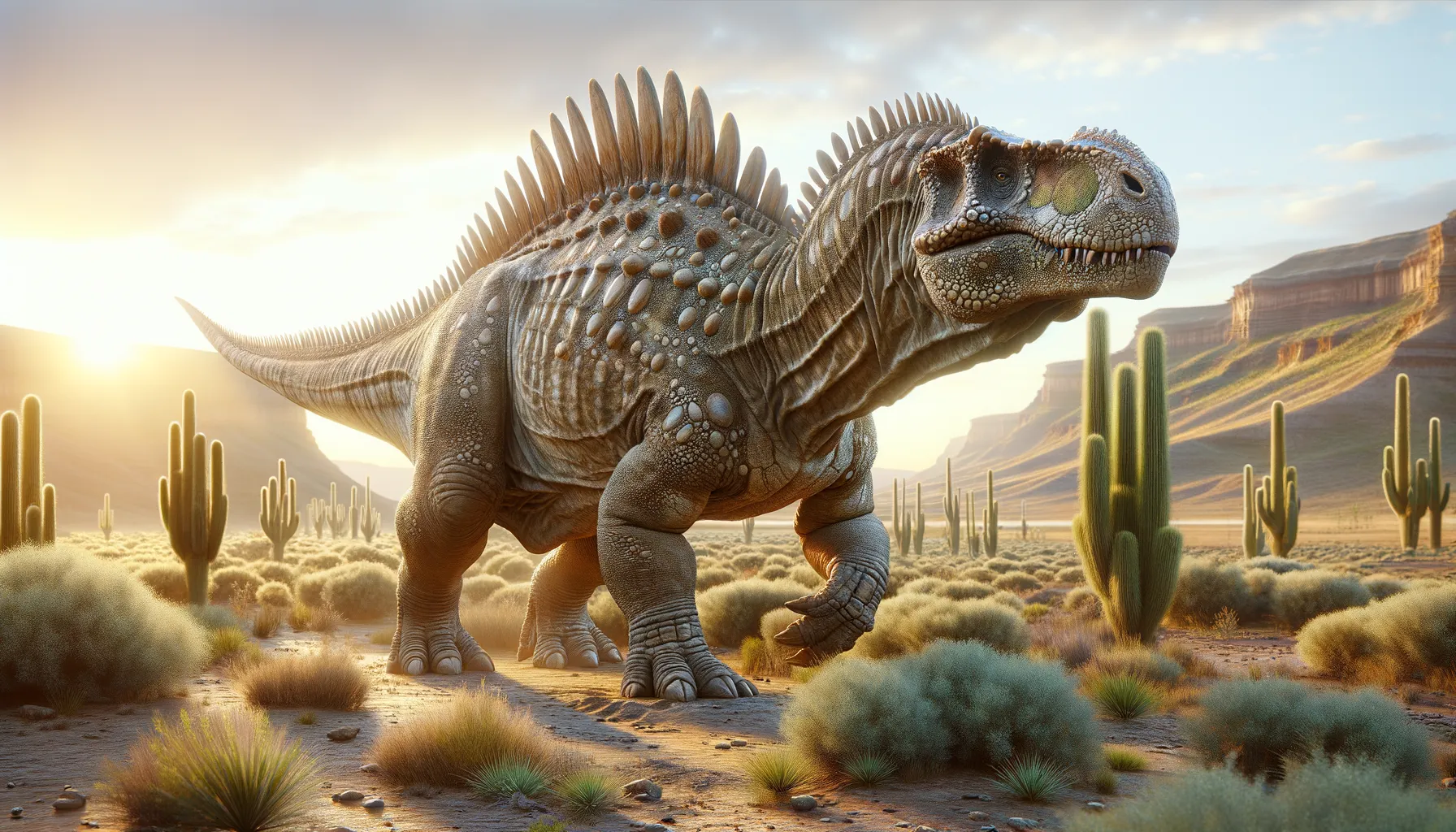
Mongolostegus
Armored giant of the Cretaceous plains!
Period
Cretaceous
Length
Its length was around 6 meters.
Height
It stood about 2.5 meters tall.
Weight
It weighed approximately 2 to 3 tons.
Mongolostegus was a herbivorous dinosaur known for its distinctive bony plates running along its back, providing both protection and temperature regulation. Originating in the Cretaceous period, this dinosaur roamed what is now the Gobi Desert. Its armored body helped defend against predators, while its massive size deterred competitors. Despite being slow, its stable gait aided in migrating across vast distances to find food.
Diet
Mongolostegus was a herbivore that fed primarily on low-lying plants and shrubs. Its diet mainly consisted of ferns, cycads, and conifers common in its habitat. With a long neck, it could reach various vegetation over a broad area.
Hunting
Mongolostegus did not hunt as it was purely herbivorous. Its primary focus was grazing and foraging for plants. It used its keen sense of smell to locate food sources.
Environmental challenges
Mongolostegus faced environmental challenges such as fluctuating climates and scarce water sources. The Cretaceous period involved cycles of droughts that made food and water limited. Additionally, it coexisted with potential predators and had to rely on its armored plates for defense. Its ability to migrate helped it evade some challenges, moving to areas with more resources.
Speed
Mongolostegus was relatively slow-moving.
Lifespan
Estimated lifespan was around 70 years.
First discovery
Mongolostegus was first discovered in the Gobi Desert.
Fun Facts
- Mongolostegus was a dinosaur that lived around 150 million years ago during the Late Jurassic period.
- It was discovered in Mongolia, which is reflected in its name, 'Mongolostegus', meaning 'Mongolian roof' referring to its bony plates.
- Mongolostegus belonged to the stegosaur family, known for their distinctive plates and spikes along their backs.
- The exact function of Mongolostegus' plates is still debated, but they might have been used for display, thermoregulation, or defense.
- This dinosaur was a herbivore, feeding on plants and likely had a grazing lifestyle similar to modern-day cows or sheep.
- Mongolostegus wasn't the largest of stegosaurs, but it still had an impressive size, with estimates suggesting it reached lengths of around 6 meters (20 feet).
- The discovery of Mongolostegus helps scientists learn more about the diversity of stegosaur species in the Asian regions during the Jurassic.
Growth and Development
Mongolostegus likely experienced rapid growth during its early years to reach its massive size quickly for protection against predators. As they matured, their bony plates developed fully, providing significant defense. Juveniles learned critical survival skills from older, more experienced members of their group. Their development included social integration, aiding in group defense and foraging.
Habitat
Mongolostegus lived in the semi-arid regions of what is now Mongolia. Its habitat consisted of vast plains and sparse forests, suitable for its grazing lifestyle. It moved with the seasons to find adequate food and water, thriving in both open areas and near forest edges. The landscape's varied terrain required adaptability for survival.
Interaction with other species
Mongolostegus likely lived in herds, providing mutual protection against predators. Its primary interactions were defensive, using its body armor as a deterrent against theropods. It coexisted with other herbivorous dinosaurs, forming mixed-species groups that could enhance survival through collective vigilance.
Natural lifespan
Mongolostegus could live naturally up to around 70 years.
Reproduction
Mongolostegus reproduced oviparously, laying clutches of eggs in sandy nests. Parents may have guarded nests to protect from predators and ensure better survival for the next generation. Hatchlings were vulnerable initially but grew quickly, benefiting from the herd's protection. It is believed that communal nesting sites were common among these dinosaurs, enhancing reproductive success.
Social behaviour
Mongolostegus was likely social, forming herds for improved protection against predators. Group living also facilitated grooming and care among individuals, including helping young members develop. Social hierarchies may have existed, guiding migration and feeding strategies. Communication within the herd was essential for coordinating movement and defense.
Fossil locations
Fossils of Mongolostegus have predominantly been found in Mongolia, specifically in the Gobi Desert region. The area's arid environment has preserved many skeletons, providing insights into its life and habitat. Discoveries in this region have been instrumental in understanding the ecological dynamics of the Cretaceous period.
